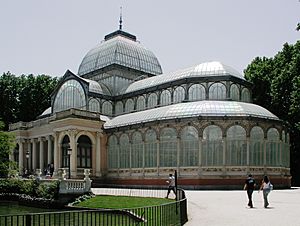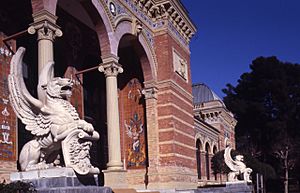Ricardo Velázquez Bosco facts for kids
Quick facts for kids
Ricardo Velázquez Bosco
|
|
|---|---|
 |
|
| Born | 1843 |
| Died | August 1923 |
| Nationality | Spanish |
| Occupation | Architect |
| Buildings | Palacio de Cristal, Palacio de Velázquez, Palacio de Fomento, Pantheon of the Duchess of Sevillano |
Ricardo Velázquez Bosco (1843–1923) was a famous Spanish architect, archaeologist, and scholar. He designed many important buildings, especially in Madrid.
Some of his most well-known buildings include the Palacio de Cristal (Crystal Palace) and the Palacio de Velázquez (Velázquez Palace). Both are located in Madrid's beautiful Parque del Buen Retiro. He also designed the large Ministry of Agriculture building. Velázquez Bosco was known for using bright, colorful ceramic tiles in his designs. He also helped restore old buildings like the Cathedral–Mosque of Córdoba. Plus, he led important digs to find ancient sites near Córdoba, like Medina Azahara.
Contents
Ricardo Velázquez Bosco's Life



Ricardo Velázquez Bosco was born in 1843 in a city called Burgos, Spain. He became a very important architect.
His Unique Architectural Style
In the late 1800s and early 1900s, using ceramics for building decoration became popular in Spain. Velázquez Bosco was one of the architects who used them a lot. His style was part of what was called "Regionalist Architecture."
He built the Palacio de Velázquez in Madrid's Retiro Park, which is named after him. This building was made for a big mining exhibition in 1883. It features beautiful ceramic tiles created by an artist named Daniel Zuloaga.
The Palacio de Velázquez and the nearby Palacio de Cristal were inspired by the famous Crystal Palace in London. Velázquez Bosco taught at the School of Architecture in Madrid. He influenced many students, including the Spanish architect Antonio Palacios. His style was known for its strong shapes and the use of ceramic decorations on the outside of buildings.
He was also a member of the Real Academia de Bellas Artes de San Fernando, a famous art academy. Ricardo Velázquez Bosco passed away in Madrid in August 1923.
Discovering Ancient History
Ricardo Velázquez Bosco was not just an architect; he was also very interested in history and old buildings. From 1910, he was the director of the Madrid School of Architecture. He also taught art history.
Exploring Ancient Sites
As an archaeologist, Velázquez Bosco helped dig up two important Islamic sites near Córdoba in 1910 and 1911.
- Madīnat az-Zahrā (Medina Azahara): This was a huge medieval city built by the Umayyad rulers of Córdoba. It had been abandoned for a long time. Velázquez Bosco's work helped rediscover this amazing place.
- Munyat al-Rummaniyya (El Cortijo Alamiriya): This dig uncovered the remains of a large country estate. It had four rectangular terraces covering about 4 hectares (10 acres). Velázquez Bosco found parts of a house there, which helped him understand how these estates were designed. Later, this site was identified as Munyat al-Rummaniyya, an estate known from old documents.
Restoring Old Buildings
Velázquez Bosco also worked on restoring and preserving important historical buildings.
- Cathedral–Mosque of Córdoba: This building was declared a national monument in 1882. Velázquez Bosco helped remove later additions to show its original beauty.
- He also worked on León Cathedral and the La Rábida Monastery.
Famous Buildings by Velázquez Bosco
Here are some of the most important buildings he designed, mostly in Madrid:
- 1881–1883: Palacio de Velázquez (for the National Mining Exhibition of 1883), working with engineer Alberto de Palacio and ceramist Daniel Zuloaga.
- 1884–1893: School of Mining Engineering of Madrid.
- 1887: Palacio de Cristal (for the Philippine Exposition of 1887), also with Alberto de Palacio and Daniel Zuloaga.
- 1893–1897: Palacio de Fomento, which now houses the Ministry of Agriculture.
- 1898: National Association of the Deaf and Blind in Madrid, now the Centro Superior de Estudios de la Defensa Nacional.
- 1917–1923: Ministry of Education (Spain).
Some of his other notable projects include:
- Reconstruction of the western facade of the Casón del Buen Retiro.
- Gamazo Palace (Madrid).
- Mining Building Council (Madrid).
- 1905–1920: Blind and Deaf School in Santiago de Compostela.
- Column commemorating the fourth centenary of the discovery of America, in Palos de la Frontera.
- 1882–1916: Pantheon of the Duchess of Sevillano, in Guadalajara, with Daniel Zuloaga.
See also
 In Spanish: Ricardo Velázquez Bosco para niños
In Spanish: Ricardo Velázquez Bosco para niños

